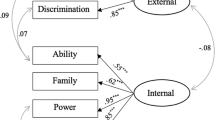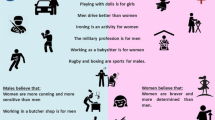Abstract
This study examines gender role attitudes and attitudes toward “man” and “woman” in two native samples from Spain and Morocco. The samples were made up of 400 participants, 200 in each country, containing the same number of men and women and selected with a similar procedure. We expected differences based on the independent variables of nationality, gender and educational level. The Spanish sample, female and student participants were predicted to present more egalitarian gender role attitudes and more positive attitudes toward “woman” than participants in the Moroccan sample, male and non-student participants. Overall MANOVAs were used to show the differences in gender role attitudes and attitudes toward “man” and “woman”. Results confirmed the role of the nationality variable in the expected way. The Spanish sample showed a more egalitarian view and more favorable attitudes toward “woman” than the Moroccan one. Educational level and gender showed significant effects on the Moroccan sample but only partially. Moroccan student females and non-student males presented a more egalitarian view than non-student females and student males respectively.
Similar content being viewed by others
References
Arends-Tóth, J., & Van de Vijver, F. J. R. (2007). Cultural and gender differences in gender-role beliefs, sharing household task and child-care responsibilities, and well-being among immigrants and majority members in The Netherlands. Sex Roles, 57, 813–824. doi:10.1007/s11199-007-9316-z.
Barberá, E., Ramos, A., Sarrió, M., & Candela, C. (2002). Más allá del “techo de cristal”. Diversidad de género [Beyond the “glass ceiling”. Gender diversity]. Revista del Ministerio de Trabajo y Asuntos Sociales, 40, 55–68.
Buhrke, R. A. (1988). Factor dimensions across different measures of Sex Role Ideology. Sex Roles, 18, 309–321. doi:10.1007/BF00288293.
Chafai, L. (1997). Las mujeres sujeto de marginación en Marruecos [Women as margination subject in Morocco]. Anales de Historia Contemporánea, 13, 35–55.
Chia, R. C., Allred, L. J., & Jerzak, P. A. (1997). Attitudes toward women in Taiwan and China. Current status, problems, and suggestions for future research. Psychology of Women Quarterly, 21, 137–150. doi:10.1111/j.1471-6402.1997.tb00105.x.
CIS, Centro de Investigaciones Sociológicas. Ministerio de la Presidencia (2011). Gobierno de España. [CIS, Center for Sociological Research, Ministry of Presidency. Government of Spain]. Retrieved from http://www-cis.es.
Cobano-Delgado, V. (2008). Repercusiones socioeducativas de las reformas del Código de Familia en Marruecos. [Socioeconomic repercussions of the Reforms of the Code of Family in Morocco]. Foro de Educación, 10, 401–424.
Coello, M. T., & Fernández, J. (2011). Actitudes hacia las mujeres de los esquemáticos frente a los no esquemáticos de género [Attitude towards women of gender schematic vs. aschematic individuals]. Psicothema, 23, 180–188.
Cota, A. A., & Xinaris, S. (1993). Factor structure of the Sex-Role Ideology Scale: Introducing a Short-Form. Sex Roles, 29, 245–358. doi:10.1007/BF00289428.
Diekman, A. B., & Eagly, A. M. (2000). Stereotypes as dynamic constructs: Women and men of the past, present, and future. Personality and Social Psychology Bulletin, 26, 1171–1188. doi:10.1177/0146167200262001.
Domínguez, M. (2010). ¿Cada vez más igualitarios? Los valores de género de la juventud y su aplicación en la práctica [More egalitarian with the pass of time? The gender values in the younghood and their application in practice]. Revista de Estudios de Juventud, 90, 103–122.
Eagly, A. H., & Chaiken, S. (2007). The advantages of an inclusive definition of attitude. Social Cognition, 25, 582–602. doi:10.1521/soco.2007.25.5.582.
Eagly, A. H., & Wood, W. (1991). Explaining sex differences in social behavior: A meta-analytic perspective. Personality and Social Psychology Bulletin, 17, 306–315. doi:10.1177/0146167291173011.
Eagly, A. H., & Wood, W. (1999). The origins of sex differences in human behavior. Evolved dispositions versus social roles. American Psychologist, 54, 408–423. doi:10.1037/0003- 066X.54.6.408.
Eagly, A. H., Makhijani, M. G., & Klonsky, B. G. (1992). Gender and the evaluation of leaders: A meta-analysis. Psychological Bulletin, 111, 3–22. doi:10.1037//0033-2909.111.1.3.
Eagly, A. H., Wood, W., & Diekman, A. B. (2000). Social Role theory of sex differences and similarities: A current appraisal. In T. Eckes & H. M. Trautner (Eds.), The developmental social psychology of gender (pp. 123–174). Mahwah, NJ: Erlbaum.
Esteban, G., Ouhida, J., Ouald Ali, K., & Saghir, T. (2009). La nueva Mudawwana marroquí: Entre tradición y modernidad [The new Moroccan Mudawwana: Between tradition and modernity]. Jaen: Junta de Andalucía.
Frieze, I. H., Ferligos, A., Kogovsek, T., Rener, T., Hoevat, J., & Saflija, N. (2003). Gender role attitudes in university students in the United States, Slovenia, and Croatia. Psychology of Women Quarterly, 27, 256–261. doi:10.1111/1471-6402.00105.
Frijda, N., & Jahoda, G. (1966). On the scope and methods of cross-cultural research. International Journal of Psychology, 1, 109–127. doi:10.1080/00207596608247118.
García-Retamero, R., Müller, S. M., & López-Zafra, E. (2011). The malleability of gender stereotypes: Influence of population size and perception of men and women in the past, present, and future. The Journal of Social Psychology, 151, 635–656. doi:10.1080/00224545.2010.522616.
Gibbons, L. J., Stiles, D. A., & Shkodriani, G. M. (1991). Adolescents’ attitudes toward family and gender roles: An international comparison. Sex Roles, 25, 625–643. doi:10.1007/BF00289568.
Gibbons, L. J., Hamby, B. A., & Dennis, W. D. (1997). Researching gender-role ideologies internationally and cross-culturally. Psychology of Women Quarterly, 21, 151–170. doi:10.1111/j.1471-6402.1997.tb00106.x.
Hambleton, R. K. (1994). Guidelines for adapting educational and psychological tests: A progress report. European Journal of Psychological Assessment, 10, 229–244.
Harris, J. H., & Firestone, J. M. (1998). Changes in predictors of gender role ideologies among women: A multivariate analysis. Sex Roles, 38, 239–252. doi:10.1023/A:1018785100469.
Hernando, M., Aixelá, Y., & Planet, A. I. (2004). Mujeres y política en el mundo árabe. [Women and politics in the Arab world]. Feminismos, 3, 149–159.
Hinshaw, L. M., & Forbes, G. B. (1993). Attitudes toward women and approaches to conflict resolution in college students in Spain and United States. Journal of Social Psychology, 133, 865–867. doi:10.1080/00224545.1993.9713952.
INE, Instituto Nacional de Estadística. Ministerio de Economia (2012). [National Institute of Statistics. Ministry of Economy]. Retrieved from http://www.ine.es/jaxi/tabla.do?type=pcaxis&path=/t00/mujeres_hombres/tablas_2/l0/&file=S3G1.px.
IOM, International Organization for Migration (2013). Retrieved from http://www.iom.int/cms/morocco.
Kalin, R., & Tilby, P. J. (1978). Development and validation of a sex-role ideology scale. Psychological Reports, 42, 731–738. doi:10.2466/pr0.1978.42.3.731.
Khalid, R., & Frieze, I. H. (2004). Measuring perceptions of gender roles: The IAWS for Pakistanis and U.S immigrant populations. Sex Roles, 51, 293–300. doi:10.1023/B:SERS.0000046613.99273.22.
Lameiras-Fernández, M., & Rodríguez-Castro, Y. (2002). Evaluación del sexismo moderno en adolescentes [Assessment of modern sexism in adolescents]. Revista de Psicología Social, 17, 119–127. doi:10.1174/021347402320007555.
Laurenzo, P. (2005). La violencia de género en la Ley Integral: Valoración político criminal. [Gender violence in the Integral Law: politic and criminal evaluation]. Revista Electrónica de Ciencia Penal y Criminología, 7, 8–23.
López-Cepedo, J., Rodríguez-Franco, L., Rodríguez-Díaz, F. J., & Bringas-Molleda, C. (2013). Validación de la versión corta del Social Roles Questionnaire (SRQ-R) con una muestra adolescente y juvenil española [Validation of the Social Roles Questionnaire Brief-Version on an adolescent and juvenile Spanish sample]. Revista Electrónica de Metodología Aplicada, 18, 1–16.
López-Sáez, M., Morales, J. F., & Lisbona, A. (2008). Evolution of gender stereotypes in Spain: Traits and roles. The Spanish Journal of Psychology, 11, 609–617.
López-Zafra, E., García-Retamero, R., Diekman, A., & Eagly, A. (2008). Dinámica de estereotipos de género y poder: un estudio transcultural [Dynamic of gender stereotypes and public power: A cross-cultural study]. Revista de Psicología Social, 23, 213–219. doi:10.1174/021347408784135788.
Matud, M. P. (2009). Violencia de Género [Gender violence]. Castellón, España: Universitat Jaume I, Servicio de Comunicación y Publicaciones.
McBride, D. E., & Mazur, A. (2010). The Politics of State Feminism. Innovations in comparative research. Philadelphia: Temple University Press.
McHugh, M., & Frieze, I. H. (1997). The measurement of gender-role attitudes. A review and commentary. Psychology of Women Quarterly, 21, 1–16. doi:10.1111/j.1471-6402.1997.tb00097.x.
Moreno, A. (2011). Flexicurity and work- family life balance in Spain from a gender perspective. Comunitaria, International Journal of Social Work and Social Sciences, 1, 89–111.
Osgood, C., Suci, G. J., & Tannenbaum, P. H. (1957). The measurement of meaning. Urbana: University of Illinois Press.
Page, M. A. (1998). El poder discriminante entre géneros de los usos del tiempo [Discriminant power of gender in time uses]. Revista de Psicología Social Aplicada, 8, 81–101.
Pelegrin, A., León, J. M., Ortega, E., & Garcés, E. J. (2012). Programa para el desarrollo de actitudes de igualdad de género en clases de educación física en escolares [Program for the development of egalitarian gender attitudes in physical exercice (PE) lessons]. Educación XXI, 15, 271–292.
Pérez, C. (2006). Sociedad civil, derechos humanos y democracia en Marruecos [Civil society, human rights and democracy in Morocco]. Granada: Universidad de Granada.
Pingree, G., & Abend, L. (2005, November 23). Morocco’s rising Islamist Challenge. The Christian Science Monitor, p. 6.
Polimeni, A. M., Hardie, E., & Buzwell, S. (2000). Homophobia among Australian heterosexuals: the role of sex, gender role ideology, and gender role traits. Current Research in Social Psychology, 5, 47–62.
Quiñones, A. (2006). Legislación sobre matrimonios, divorcios y sucesiones. África del Norte y América Latina. [Legislation on marriage, divorce and inheritance. North Africa and Latin America]. Barcelona: Atelier.
Rice, T. W., & Coates, D. L. (1995). Gender role attitudes in the southern United States. Gender and Society, 9, 738–750. doi:10.1177/089124395009006007.
Rollero, C. (2013). Sexist attitudes and support for status quo. Psicología Política, 46, 117–128.
Sánchez, L., & Hall, C. S. (1999). Traditional values and democratic impulses: The gender division of labor in contemporary Spain. Journal of Comparative Family Studies, 30, 659–685.
Sánchez, M., Suarez, M., Manzano, N., Oliveros, L., Lozano, S., Fernadez, B., & Malik, B. (2011). Estereotipos de género y valores sobre el trabajo entre los estudiantes españoles. [Gender stereotypes and work values of Spanish students]. Revista de Educación, 55, 331–354. doi:10.4438/1988-592X-RE-2011-355-027.
Schneider, D. J. (2004). The psychology of stereotyping. New York, NY: The Guilford Press.
Silván-Ferrero, M. P., & Bustillos, A. (2007). Benevolent sexism toward men and women: Justification of the traditional system and conventional gender roles in Spain. Sex Roles, 57, 607–614. doi:10.1007/s11199-007-9271-8.
Spencer, J. T., & Hahn, E. D. (1997). The attitudes toward women scale and attitudes change in college students. Psychology of Women Quarterly, 21, 17–34. doi:10.1111/j.1471-6402.1997.tb00098.x.
Tu, S., & Liao, T. (2005). Gender differences in gender role attitudes: A comparative analysis of Taiwan and Coastal China. Journal of Comparative Family Studies, 36, 545–566.
Twenge, J. M. (1997). Attitudes toward women. 1970–1995. A meta-analysis. Psychology of Women Quarterly, 21, 35–51. doi:10.1111/j.1471-6402.1997.tb00099.x.
Valiente, C. (2002). An overview of research on gender in Spanish society. Gender & Society, 16, 767–792. doi:10.1177/089124302237887.
Van de Vijver, F. J. R., & Hambleton, R. K. (1996). Translating tests: Some practical guidelines. European Psychologist, 1, 81–99. doi:10.1027/1016-9040.1.2.89.
Van de Vijver, F. J. R., & Leung, K. (1997). Methods and data analysis for cross-cultural research. Thousand Oaks, CA: Sage.
Viñao, A. (2009). La alfabetización en España: Un proceso cambiante de un mundo multiforme [Literacy in Spain: A changing process in a multiform world]. In P. L. Moreno Martínez & C. Navarro García (Eds.), Perspectivas históricas de la educación de personas adultas [Historical perspectives of adult education], Vol. 3 (pp. 5–19). Salamanca, España: Universidad de Salamanca.
WBO, World Bank Organization (2013). Retrieved from http://www.worldbank.org/countries/Morocco; http://www.worldbank.org/countries/Spain.
Williams, J. E., & Best, D. L. (1990). Sex and psyche: Gender and self viewed cross-culturally. Newbury Park, CA: Sage.
Wood, W., & Eagly, A. H. (2002). A cross-cultural analysis of the behavior of women and men: Implications for the origins of sex differences. Psychological Bulletin, 128, 699–727. doi:10.1037//0033-2909.128.5.699.
Yount, K. M. (2005). Women’s family power and gender preference in Minya, Egypt. Journal of Marriage and the Family, 67, 410–428. doi:10.1111/j.0022-2445.2005.00125.x.
Acknowledgments
We thank Jane Powell and Alan Pickering for their assistance with this manuscript.
Author information
Authors and Affiliations
Corresponding author
Rights and permissions
About this article
Cite this article
Díaz, A., Sellami, K. Traits and Roles in Gender Stereotypes: A Comparison between Moroccan and Spanish Native Samples. Sex Roles 70, 457–467 (2014). https://doi.org/10.1007/s11199-013-0335-7
Published:
Issue Date:
DOI: https://doi.org/10.1007/s11199-013-0335-7




